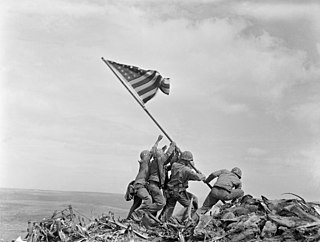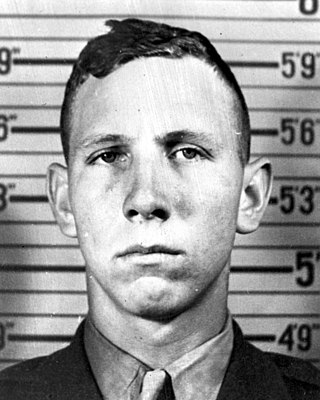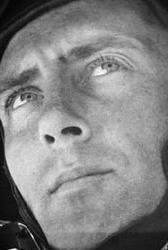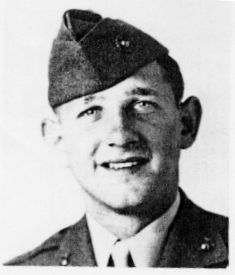
The Battle of Iwo Jima was a major battle in which the United States Marine Corps (USMC) and United States Navy (USN) landed on and eventually captured the island of Iwo Jima from the Imperial Japanese Army (IJA) during World War II. The American invasion, designated Operation Detachment, had the purpose of capturing the island with its two airfields: South Field and Central Field.

Sands of Iwo Jima is a 1949 war film starring John Wayne that follows a group of United States Marines from training to the Battle of Iwo Jima during World War II. The film, which also features John Agar, Adele Mara and Forrest Tucker, was written by Harry Brown and James Edward Grant, and directed by Allan Dwan. The picture was a Republic Pictures production.

Ira Hamilton Hayes was an Akimel O'odham Native American and a United States Marine during World War II. Hayes was an enrolled member of the Gila River Indian Community, located in Pinal and Maricopa counties in Arizona. He enlisted in the United States Marine Corps Reserve on August 26, 1942, and, after recruit training, volunteered to become a Paramarine. He fought in the Bougainville and Iwo Jima campaigns in the Pacific War.

Raising the Flag on Iwo Jima is an iconic photograph of six United States Marines raising the U.S. flag atop Mount Suribachi during the Battle of Iwo Jima in the final stages of the Pacific War. The photograph, taken by Joe Rosenthal of the Associated Press on February 23, 1945, was first published in Sunday newspapers two days later and reprinted in thousands of publications. It was the only photograph to win the Pulitzer Prize for Photography in the same year as its publication, and was later used for the construction of the Marine Corps War Memorial in 1954, which was dedicated to honor all Marines who died in service since 1775. The memorial, sculpted by Felix de Weldon, is located in Arlington Ridge Park, near the Ord-Weitzel Gate to Arlington National Cemetery and the Netherlands Carillon. The photograph has come to be regarded in the United States as one of the most significant and recognizable images of World War II.

Harlon Henry Block was a United States Marine Corps corporal who was killed in action during the Battle of Iwo Jima in World War II.

René Arthur Gagnon was a United States Marine Corps corporal who participated in the Battle of Iwo Jima during World War II.

Michael Strank was a United States Marine Corps sergeant who was killed in action during the Battle of Iwo Jima in World War II. He was one of the Marines who raised the second U.S. flag on Mount Suribachi on February 23, 1945, as shown in the iconic photograph Raising the Flag on Iwo Jima by photographer Joe Rosenthal. Of the six Marines depicted in the photo, Strank was the only one to be correctly identified from the beginning; the other five were either assigned the wrong locations, or, were given the names of Marines who were not in the photo.

John Henry "Jack" "Doc" Bradley was a United States Navy Hospital corpsman who was awarded the Navy Cross for extraordinary heroism while serving with the Marines during the Battle of Iwo Jima in World War II. During the battle, he was a member of the patrol that captured the top of Mount Suribachi and raised the first U.S. flag on Iwo Jima on February 23, 1945.

Franklin Runyon Sousley was a United States Marine who was killed in action during the Battle of Iwo Jima in World War II. He was one of the six marines who raised the second of two U.S. flags on top of Mount Suribachi on February 23, 1945, as shown in the iconic photograph Raising the Flag on Iwo Jima.

Henry Oliver Hansen was a United States Marine Corps sergeant who was killed in action during the Battle of Iwo Jima in World War II. He was a member of the patrol that captured Mount Suribachi, where he helped raise the first U.S. flag on Iwo Jima on February 23, 1945. He was killed six days later.

Ralph Anthony "Iggy" Ignatowski was a United States Marine Corps private who was captured and killed by the Japanese in the Battle of Iwo Jima during World War II. He was a member of the Marine rifle company platoon that climbed to the top of Mount Suribachi and raised the American flag on February 23, 1945.

Ernest Ivy "Boots" Thomas Jr. was a United States Marine Corps platoon sergeant who was killed in action during the Battle of Iwo Jima in World War II. He was awarded the Navy Cross for extraordinary heroism while fighting for and at the base of Mount Suribachi. Two days later he was a member of the patrol that captured the top of Mount Suribachi where he helped raise the first U.S. flag on Iwo Jima on February 23, 1945. He was killed eight days after that.
Harold George Schrier was a United States Marine Corps lieutenant colonel who served in World War II and the Korean War. In World War II, he was awarded the Navy Cross for leading the patrol that captured the top of Mount Suribachi, where he helped raise the first U.S. flag on Iwo Jima on February 23, 1945. In the Korean War, he was wounded in North Korea during the Battle of Chosin Reservoir while commanding a rifle company.

Shadow of Suribachi: Raising The Flags on Iwo Jima (1995) is a book released during the 50th anniversary of the flag-raising(s) atop Mount Suribachi on Iwo Jima during World War II which was written by Parker Bishop Albee, Jr. and Keller Cushing Freeman. The book mainly examines the controversy over the identification of the flag-raiser who was positioned at the base of the flagpole in Joe Rosenthal's Raising the Flag on Iwo Jima photograph of the second flag-raising on February 23, 1945.
Charles W. Lindberg was a United States Marine Corps corporal who fought in three island campaigns during World War II. During the Battle of Iwo Jima, he was a member of the patrol which captured the top of Mount Suribachi where he helped raise the first U.S. flag on the island on February 23, 1945. Six days later, he was wounded in action.

Raymond E. Jacobs was an American and United States Marine Corps sergeant who served in combat during World War II. Jacobs was a member of the combat patrol that climbed up to the top of Mount Suribachi during the Battle of Iwo Jima and raised the first U.S. Flag on February 23, 1945. Afterwards, he was a news reporter and had served during the Korean War as an instructor at Camp Pendleton, California.

Harold Henry Schultz was a United States Marine corporal who was wounded in action during the Battle of Iwo Jima in World War II. He was a member of the patrol that captured the top of Mount Suribachi and raised the first U.S. flag on Iwo Jima on February 23, 1945. He is also one of the six Marines who raised the larger replacement flag on the mountaintop the same day as shown in the iconic photograph Raising the Flag on Iwo Jima.

Harold Paul Keller was a United States Marine corporal who was wounded in action during the Bougainville campaign in World War II. During the Battle of Iwo Jima, he was a member of the patrol that captured the top of Mount Suribachi and raised the first U.S. flag on Iwo Jima on February 23, 1945. He is one of the six Marines who raised the larger replacement flag on the mountaintop the same day as shown in the iconic photograph Raising the Flag on Iwo Jima.
Chandler Wilce Johnson was a highly decorated United States Marine Corps lieutenant colonel. He served as the commanding officer of 2nd Battalion, 28th Marines during the battle of Iwo Jima, leading his battalion in capturing Mount Suribachi which later led to the flag being raised over Iwo Jima. He was killed in action one week after the flag raising and was posthumously awarded the Navy Cross.
Dave Elliott Severance was a United States Marine Corps colonel. During World War II, he served as the commanding officer of Easy Company, 2nd Battalion, 28th Marines and led his company in the battle of Iwo Jima. During the battle, Severance ordered his 3rd Platoon to scale Mount Suribachi and raise the flag at the summit.
















